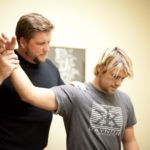The Chiropractic Center is pleased to provide education and information from a variety of trusted, professional resources. Our goal is to increase the knowledge and comfort of our patients across a wide spectrum of interests affecting their health and well being.
If you have specific questions or concerns you’d like to discuss personally with us, please click here . It would be our pleasure to ensure your complete understanding of the science of chiropractic treatments or other subjects covered in the article below.
The Nordic back pain subpopulation program: Can low back pain patterns be predicted from the first consultation with a chiropractor? A longitudinal pilot study.
Alice Kongsted  and Charlotte Leboeuf-Yde
and Charlotte Leboeuf-Yde 
Chiropractic & Osteopathy 2010, 18:8doi:10.1186/1746-1340-18-8
| Published: | 29 April 2010 |
Abstract (provisional)
Background
It is widely believed that non-specific low back pain (LBP) consists of a number of subgroups which should be identified in order to improve treatment effects. In order to identify subgroups, patient characteristics that relate to different outcomes are searched for. However, LBP is often fluctuating or recurring rather than clearly limited in time. Therefore it would be relevant to consider outcome from a longitudinal perspective (describing ‘course patterns’) instead of defining it from an arbitrarily selected end-point after completed treatment.
Aims
The objectives of this pilot study were to investigate the interobserver reliability of a diagnostic classification system and to evaluate whether diagnostic classes or other baseline characteristics are associated with the LBP course pattern over a period of 18 weeks.
Methods
Patients visiting one of 7 chiropractors because of LBP were classified according to a diagnostic classification system, which includes end-range loading, SI-joint pain provocation tests, neurological examination and tests for muscle tenderness and abnormal nerve tension. In addition, age, gender, duration of pain and presence of leg pain were registered in the patient’s file. By weekly SMS-messages on their mobile phones, patients were asked how many days they had LBP the preceding week, and these answers were transformed into pain course patterns and the total number of LBP days.
Results
A total of 110 patients were included and 76 (69 %) completed follow-up. Thirty-five patients were examined by two chiropractors. The agreement regarding diagnostic classes was 83% (95 % CI: 70 – 96). The diagnostic classes were associated with the pain course patterns and number of LBP days. Patients with disc pain had the highest number of LBP days and patients with muscular pain reported the fewest (35 vs. 12 days, p<0.01). Men had better outcome than women (17 vs. 29 days, p < 0.01) and patients without leg pain tended to have fewer LBP days than those with leg pain (21 vs.31 days, p=0.06). Duration of LBP at the first visit was not associated with outcome.
Conclusions
The study indicated that there is a clinically meaningful relationship between diagnostic classes and the course of LBP. This should be evaluated in more depth.






